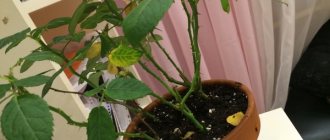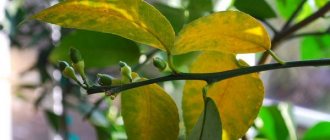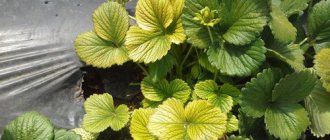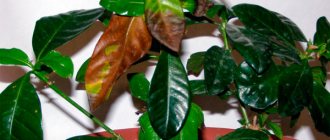Growing tomatoes is a long process, starting in February - March and ending closer to autumn.
During this time, summer residents encounter many problems. This time we will figure out why tomato leaves turn yellow. Dear readers!
For you, we have created communities on social networks in which useful articles and interesting ideas are published several times a day! Subscribe and receive useful content in a convenient format! Let's consider the most common causes of yellowing, as well as ways to solve this problem.
Reasons for yellowing of tomato leaves
Right off the bat, you can name almost a dozen different reasons why your plants’ leaves have turned yellow. All of them are associated with improper care of the crop.
Thus, tomatoes signal that the created growing conditions are not suitable for them.
Tomatoes lack nutrition
In general, tomatoes are not considered a “gluttonous” crop. Usually they have enough nutrients that are already contained in the soil, as well as rare spot feedings.
However, it also happens that there is a deficiency of some microelement in the diet. In this case, the plant signals by changing the color of the leaf blade.
What to do
It is necessary to feed the plant with fertilizer containing the necessary substances.
Yellowing due to soil
Tomatoes love loose, fertile soil. Heavy soil causes a deficiency of microelements and depletes plants. As a result, the leaves turn yellow.
What to do
Fertilize with complex fertilizer. For example, Azofoska or Nitrophoska. In spring and autumn, add organic matter, and during the growing season, fertilize with a yeast solution.
Tomatoes planted too close
For tomatoes to grow well, they need at least 40 cm of space between neighboring bushes. Of course, there are low-growing varieties that can get by with a smaller area, but on average this is exactly the value.
When planted too frequently, neighboring plants do not have adequate nutrients in the soil. In addition, they block each other from sunlight. As a result, all bushes planted close to each other begin to hurt.
What to do
In this case, it is already too late to do anything. We can only advise you to plant the tomatoes, tie them up and periodically spray them with growth stimulants. But these are all half measures that will not solve the problem.
Plants don't have enough light
This reason is related to the previous one. Due to dense plantings, the lower leaves do not have enough light and they begin to turn yellow.
What to do
In this particular case, only stepsoning can help. This procedure will slightly thin out the tomato crown. But in general, try to avoid thickening the tomato plantings, as this is fraught not only with yellowing of the foliage, but also with the spread of fungal diseases.
Improper watering
Improper moisture regime is one of the most common causes of yellowing foliage. Moreover, this is true both when there is a shortage of water and when there is an excess of it.
With excessive watering, the leaves begin to turn yellow and become watery. This begins the process of rotting.
What to do
First of all, normalize the watering regime. Tomatoes need to be watered every day only in case of very intense heat and drought.
In normal weather, moisturizing should occur every 3-4 days. Watering should be plentiful and carried out strictly at the root.
If you have already watered the tomatoes, be sure to loosen the soil to provide air access to the roots and to allow the soil to dry out faster.
Incorrect temperature
For tomatoes, moderately warm weather during the day and night (25 and 18 degrees), respectively, is optimal.
An increase or decrease in temperature can equally cause changes in the color of leaf blades. Temperature changes are especially harmful when the day is very hot and the night is cold.
What to do
Of course, there is little that can be done about the wrong temperature. Especially if the tomatoes grow in a regular garden without shelter.
But here, too, there are a few tricks to help the plants. Use portable greenhouses and cover the bushes with old buckets. All this will help equalize the temperature.
Incorrect feeding
Improper feeding is closely related to nutrient deficiencies in the tomato diet. You need to apply fertilizers wisely, understanding which element is responsible for what. Thoughtless addition of organic matter or “mineral water” leads to plant diseases.
What to do
Normalize the diet of plants.
Diseases and pests
An attack by parasitic insects and infection with fungal infections can also cause a change in the color of the leaf blades.
What to do
Spraying with fungicides and insecticides will help cope with the problem.
Plants have a weak root system
Yellow foliage may be a sign of a weakened root system. If tomato roots do not absorb nutrients from the soil well, this will inevitably affect the above-ground part of the plant.
The roots can be damaged during transplantation and can be chewed by pests.
What to do
Plants need to be treated with a solution of a root formation stimulator.
ON A NOTE. But remember that it will not help if the damage is severe.
Why do the leaves of tomato seedlings turn yellow and dry?
Yellowing of the leaves of tomato seedlings is most often associated with errors in care or improper growing conditions.
Yellowing of seedling leaves is most often the result of hypothermia and improper watering
1. Small container. Cramped conditions do not allow the root system of seedlings to develop normally. This means that the leaves will certainly turn yellow and fade.
2. Excessive or insufficient watering. To prevent the seedlings from drying out and rotting, water them moderately.
3. Hypothermia. Maintain the optimal temperature for the development of tomato seedlings – 18-22°C.
4. Lack of nitrogen. For good growth, seedlings need a sufficient amount of nitrogen in the soil. If you follow all the recommended growing conditions and the leaves still turn yellow, the plants may need nitrogen supplementation.
5. Lack of lighting. Without good sunlight, photosynthesis is impossible. It is not surprising that tomato seedlings begin to turn yellow in dark rooms.
6. Soil acidity. It is easier to prevent any problem than to fix it. Therefore, it is advisable to initially use specially prepared soil for growing seedlings. If it turns out that the soil in the containers with seedlings is sour, the situation can be corrected by adding a little ash.
Signs of micronutrient deficiency
It often happens that the reason for the yellowing of tomato leaves is hidden in a deficiency of some microelement.
Yellowing occurs when there is a lack of one of the following components in the tomato diet: nitrogen, sulfur, magnesium, potassium and iron.
Let's look at how a deficiency of each of them manifests itself, and what needs to be done to bring tomatoes back to normal.
Nitrogen deficiency
9 out of 10 cases of micronutrient deficiency in plants are due to nitrogen deficiency. The foliage turns pale and becomes lethargic. Nitrogen is very important for the growth of tomatoes, so its deficiency should not be allowed under any circumstances.
For feeding, it is best to use urea (a matchbox of granules per 10 liters of water) or ordinary ammonia (3 spoons per the same amount of water).
Lack of sulfur
If a plant lacks sulfur, this is most often determined by the paleness of the plant leaves. They become yellow-green and lifeless. In addition, reddish veins appear.
They solve the problem by feeding with ammoniated superphosphate. By the way, you shouldn’t overuse fertilizer either.
Feed once and look at the result. If nothing has changed, then carry out another treatment.
If you are low on iron
The deficiency of this element is determined by yellow leaf blades with veins that have retained their color. The crown may also wilt.
You can replenish the lack of iron by treating the plant with iron sulfate (5 grams per bucket of water). Such treatments need to be carried out 2 times with an interval of 7 days.
Magnesium deficiency
The lack of magnesium is compensated by feeding with magnesium sulfate. The deficiency itself can be defined as yellowing of the interveinal space of tomato leaves.
The shortage is compensated through spraying. A standard ten-liter bucket of water contains 20 grams of the drug.
How to determine if you are deficient in potassium
If there is not enough potassium in the tomato diet, the “old” leaves will turn yellow and dry out. But the new leaves curl up.
If you notice this on your tomatoes, then treat them with potassium sulfate (20 grams per half bucket of water). Treatment can be carried out by root and foliar methods.
The top leaves of tomatoes turn yellow
When the young shoots on top turn yellow first, they lack nutrients. Useful minerals simply do not reach them, so it’s time to fertilize or spray.
— If yellow spots appear along the veins or in the middle of the plates, there is little iron. After feeding with 1% chelate or vitriol, the problem will disappear in a couple of days. Do not just use salts, because they interfere with the absorption of phosphorus;
— With calcium deficiency, the leaves begin to change from the very tips. The second indirect sign is if the flowers begin to fly around. And when the tomatoes already bear fruit, dark spots appear on them, which quickly increase;
— When the bases of the leaves become deformed, and not the edges as usual, and then change color, a weak solution of boric acid is needed. A lack of boron in the future may lead to the death of the ovaries and a deterioration in the taste of the crop;
— Red veins on yellow plates and weak woody shoots are symptoms of sulfur deficiency. In this case, magnesium sulfate is best;
— Uneven spots along the plates that turn pale and give off a yellowish tint are a reason to treat them with potassium permanganate. It is also a good antiseptic that prevents the development of fungal diseases. Vary the concentration from 1 to 3 g, depending on the intensity of the problem.
Why do leaves turn yellow in a greenhouse?
In closed ground (greenhouses and greenhouses), tomatoes usually turn yellow for the same reasons: poor watering, underfed or overfed with fertilizers, pests, etc.
However, there are specific reasons why yellowing occurs indoors. First of all, there is a lack of light for those plants that are planted in the depths of the greenhouse.
Then there are problems with air humidity. It may be excessive due to excessive watering and, as a result, strong evaporation.
Yellow foliage can also be a sign of sunburn. This is typical for those specimens that are planted near the walls of the greenhouse and their leaves touch the glass.
Greenhouse glass acts as a lens that refracts light and causes damage to tomatoes.
Natural causes
There are a number of natural factors why tomato leaves turn yellow and dry:
- The end of its lifespan - the leaf lives on average 3 months and by mid-summer the very first ones have already served their purpose and begin to die off. They turn yellow and dry out even on healthy bushes.
- The leaves of tomato seedlings may turn yellow due to the tightness of the root system. After transplantation, the plates can restore normal color.
- The leaves of seedlings also turn yellow due to lack of light - most varieties of tomatoes require additional lighting after emergence.
- Stress after transplanting into a greenhouse or open ground. The plant finds itself in completely different conditions and in order to quickly adapt to them, the bush gets rid of excess tops.
- In addition, during this period there is a temporary disruption in the supply of water and nutrients. The plant in such situations (as in drought) tries to maintain viability and rejects old leaves in favor of young ones. Disturbed root nutrition after transplanting bushes with bare roots is restored in 7-10 days.
- The natural reasons why only the tips of the leaves of tomato bushes turn yellow include the result of hypothermia of the roots after transplanting into a greenhouse or garden beds. This can only be combated by covering the plantings with spunbond or installing temporary greenhouses, creating comfortable conditions.
In all these cases, you should not panic, but just wait a few days. The situation will correct itself.
Why do tomato leaves dry out?
Drying of tomato leaves can be caused by both root defects and the spread of a fungal infection. For example, with late blight, the leaves look completely dried out.
Treat the bush with a fungicide or root stimulator.
Another possible reason is too dry air. Then it is necessary to pay more attention to watering the tomatoes, and periodic spraying of the plants is also allowed to raise the humidity level.
Wet mode
Providing tomatoes with sufficient moisture is one of the main tasks of a gardener. This is not easy to do, especially if the site is outside the city or in the middle of a field. During prolonged drought, in order to preserve the harvest, the bushes reduce the area of moisture evaporation - the leaves dry out below, and at the top they turn yellow and curl. What to do? We need to think about how to organize regular watering. A great idea is a gravity drip system. You can bury a plastic bottle of water near each bush.
Plants suffer not only from a lack of moisture, but also from an excess of moisture. Due to prolonged rainfall, which washes nutrients from the soil, chlorosis of tomato leaves begins. Excess moisture can be removed only by digging drainage grooves that drain water outside the beds. The addition of urea or nitroammophoska at the rate of 2 g per 1 sq.m. will help restore nutritional deficiency.
Another danger why tomatoes turn yellow after planting in the ground is a high groundwater level. If such a factor is present on the site, you need to take care in advance about the comfort of the tomato roots. This will help with the arrangement of drainage, ridge ridges or the construction of high beds.
Only the edge of the leaf turns yellow
This means your diet is lacking in potassium or nitrogen.
You need to compensate for the deficiency of microelements with the help of urea (1/2 matchbox per standard ten-liter bucket of water) or potassium nitrate (heaped tablespoon per standard ten-liter bucket of water).
ON A NOTE. It is easy to determine that there is little potassium, since young leaves curl, and old leaves turn yellow along the edges.
Problems with the root system
Often tomatoes turn yellow, the leaves dry out due to poorly developed or damaged roots, which are unable to provide adequate nutrition to the above-ground part, especially during the period of filling and ripening of the crop. The reasons for this can be very different:
- inaccurate picking, transplanting and disembarking;
- pests;
- excess nitrogen fertilizers (fatting seedlings);
- damage to roots during loosening.
There is only one way to help tomatoes with root yellowing of leaves - you need to urgently treat the plant with a growth and root formation stimulator. These are Epin, Larixin, Heteroauxin, Novosil, Kornevin. The solution should be watered onto the soil under the bushes.
And to help the plant recover faster, you should apply foliar feeding with nutrients. Such folk remedies as yeast solution and infusion of nettle, other weeds, as well as ECO fertilizers and stimulants help very well.
If the cause is root rot, in the initial stages of fungal infection the soil must be treated with Previkur, Tiovit, Cumulus or colloidal sulfur. In case of generalized infection of the entire bed, the means to treat the bushes and soil is
0.25% suspension of Metaxyl or Ridomil Gold MC. If it doesn’t help, burn the plants, sterilize the soil and sow mustard or radish on the green manure.
Why does the leaf turn yellow and curl?
There are 2 reasons for this.
- Nutritional deficiency. Add complex fertilizers for tomatoes and peppers or feed the plants with an ash solution.
- Pests. Aphids and mites cause leaf blades to curl. You can get rid of insects with a solution of ammonia or an insecticide (for example, Biotlin).
ON A NOTE. Another reason is not related to adult plants, but to seedlings. If the seedlings' leaves begin to grow quickly, they may curl into a tube along the central vein.
The lower leaves of tomatoes turn yellow
For adult plants, yellowness from below is a normal biological course of events, because they develop and age. Tomatoes shed “ballast” to concentrate resources on the development of young shoots and fruit formation. If there are no other symptoms and you are in good condition, you do not need to do anything.
Sometimes the lower leaves wither immediately after transplantation - this is a natural reaction of sprouts to stress. You need to keep the top healthy, and the seedlings can handle the rest on their own. When the leaves below finally die off, just remove them as soon as possible so as not to create favorable conditions for diseases.
What fertilizers can be used against yellowing?
If it is impossible to accurately determine the cause of yellowing, then use complex preparations. For example, Azofoska or Nitrophoska. You can use ready-made liquid and granular preparations: Agricola, Gmi-Omi, Gera, etc.
If you can determine the deficiency of some element based on a specific sign, then feed it with the appropriate fertilizer. For example, urea if there is a lack of nitrogen.
What to do if the leaves of tomatoes wither and turn yellow
Withered and yellowed tomato leaves are most often the result of hypothermia or insufficient watering of the plants.
1. “Warm” the tomatoes. To do this, place them in a warm place and water them with water at room temperature.
2. Feed the tomatoes. Wilting and yellowing of leaves may be due to a deficiency of essential elements. You can use complex nitrogen fertilizers.
3. Remove seedlings from bright sun. Direct sunlight can also depress tomatoes. Ideal lighting is diffused light.
Traditional methods of combating yellowing of tomato leaves
There are no special folk methods for yellowing leaves. But there are folk methods of combating the causes of yellowing.
To prevent infection with fungal diseases, tomatoes are treated with a solution of iodine and whey.
To protect against insects, seedlings are dusted with ash and protective plants are planted nearby: calendula, marigolds.
The beds are mulched to normalize soil moisture.
They also fertilize with organic fertilizers.
All this helps prevent changes in leaf color and the further development of various diseases.
Diseases that affect culture
Diseases are also one of the causes of yellowing leaves. They occur in several cases: with excess moisture or improper care of plants. It is necessary to fight diseases with special drugs.
Fusarium
This disease is caused by fungal spores. The disease affects roots, stems, tops and fruits. Although the plant is affected at any period of its growth, it is especially common during the formation of fruits.
Symptoms of the disease include yellow leaves that curl and wilt. When cut through the stem, brown vessels will be visible. The disease affects the bottom of the plant, smoothly moving to the top.
If fusarium has already appeared on a plant, it must be destroyed so that the infection does not spread further. Preventive methods include treating seeds with fungicides before planting, as well as tilling the soil. Plants must be planted at a distance of 30 cm from one another, weeds must be controlled in a timely manner and the soil must be loosened.
Late blight
A fungal disease that manifests itself by the formation of brown spots on yellowing leaves.
If this disease is detected, the infected parts should be destroyed and the greenhouse should be ventilated to reduce humidity.
After this, healthy plants must be treated with biological preparations, for example, using Fitosporin or Trichophyte. After spraying, it is necessary to rinse the tomatoes that will be eaten especially thoroughly.
Chemicals “Quadris”, “Hom” and “Ridomil” can be used only if the crop begins to ripen in a month. They are also used after harvest to disinfect the greenhouse and soil.
For prevention purposes, you can use a solution of 15 drops of iodine, a liter of milk and 9 liters of water. Spraying with this product helps to form a film on the surface, thanks to which harmful bacteria cannot penetrate inside.
Prevention measures
Preventive measures to prevent yellowing of tomato foliage are, by and large, not at all complicated. You just need to maintain the right conditions for your tomatoes.
Namely: protection from UV rays, regular watering and fertilizing, sufficient space for tomatoes to grow, timely planting.
It is also worth mentioning here about pinching and regular inspection of plants for the appearance of pests or diseases.
Tomatoes are not a very capricious crop, but they do not tolerate lack of attention. To prevent yellowing of the foliage, you just need to follow simple instructions for growing this crop.
Lighting
Another factor from the list of reasons is a lack or excess of light. Yellowing of the leaves of tomato seedlings occurs in the first month, when there is not enough natural light, and the seedlings become elongated, thinner, and pale. Additional lighting helps correct the situation, but when planting, plants must be buried.
Tomatoes are light-loving plants; planting in shaded areas leads to the tops of the tomatoes turning yellow and a sharp decrease in yield. What to do - practically nothing. Is it possible to try transplanting a bush with a large lump of earth into a lighted place.
Density of plantings also leads to insufficient insolation. Per square meter it is optimal to plant 4 bushes of standard tomatoes and 4-5 bushes formed into one stem.
Too much sun is also dangerous for tomatoes. Tomatoes in a greenhouse especially often suffer - their leaves turn yellow from too bright rays, especially when the bushes are not yet strong enough. After planting, it is advisable to shade the plants for at least 2 weeks. Spraying the bush in the morning if hot weather is expected can also help. You can throw on white lutrasil or spunbond - this will reduce the temperature in the greenhouse.
Common mistakes
Now a few words about common mistakes made by summer residents:
- No preventive measures are being taken. Most often, gardeners themselves become the cause of yellowing of tomato leaves. Planting too close, improper watering, improper fertilizing - all these are manifestations of improper crop care.
- Everything is done the other way around. For some reason, it is most often believed that in case of any problem, plants need to be watered and fed. Although very often it happens exactly the opposite: you need to exclude fertilizing and watering for at least a few days.
- Ignoring the problem. It also happens that yellowing is completely ignored. As a result, the disease spreads and the bush dies. Although at the very beginning it was still possible to save him.
Tomato leaves turn yellow after planting
Planting is always stressful for seedlings, and it affects their well-being and appearance. Adaptation is a normal feature of the life cycle, not limited to plants. But if the situation does not stabilize on its own in the near future, the reasons may lie deeper.
— A fungus or larvae of pests could remain in the soil, which now eat the young seedlings;
— When replanting, it is especially easy to damage the delicate root system. If the damage is minor, the plants will return to normal on their own;
— Sprouts react most quickly to improper watering, so monitor the moisture level of the substrate;
- If it turns out that it is still too cold outside, the tender young foliage of the seedlings will turn yellow. Wait for stable warming, because the rush to replant can cause damage to the crop. It could even be June in the northern regions.
Types of damage to the leaf blade and their causes
Based on the nature of the lesion, you can determine the cause and choose a way to combat it.
Yellowing of the upper leaves
The main reason why the upper leaves of tomatoes turn yellow, but the yellowness does not spread to the lower leaf plates is a lack of individual nutrients.
- Calcium deficiency . In this situation, the upper leaves turn yellow, they become deformed, and the flowers fall off. The deficiency should be compensated by adding calcium nitrate at the rate of 20 g per 10 liters of water.
- Sulfur fasting . With a lack of sulfur, the stems become lignified, become thin, the veins acquire a red tint, and the leaf blade turns yellow. To save the situation, you need to spray the plantings with magnesium sulfate at the rate of 10 g per 10 liters of water.
- Little iron . With such starvation, yellow spots appear in the middle of the leaves. The green color can be restored by treating the vegetative mass of the bush with iron chelate.
- Manganese deficiency . Symptoms of manganese deficiency are similar to those of iron deficiency, only the leaf veins turn yellow. To correct the situation, you need to spray the bushes with a solution of potassium permanganate.
- Boron fasting . If the diet is low in boron, the leaves on the crown remain green, but deformation occurs at their base. If the bushes are left untreated, the leaves will turn yellow and fall off. To restore the boron content in the soil, you need to spray with boric acid at the rate of 10 g per 10 liters of water.
Yellowness on lower leaves
The situation when the lower leaves of a tomato turn yellow can be seen quite often. This is not as bad as yellowing of the upper leaf blades. Sometimes this indicates a disease in the tomato bushes, but more often the cause is the aging process.
To prevent mass yellowing of the lower leaf blades, you need to do the following:
- Water moderately and regularly;
- do not overcool the plants;
- carry out fertilizing according to the planned scheme;
- conduct preventive control of diseases and pests;
- replenish identified nutritional deficiencies of certain elements.
Important! Yellowed leaves will fall off over time. However, it is recommended not to wait for this moment, but to remove them in advance. To remove it carefully, tilt the leaf down, pressing it against the stem, then slowly pull it up.
Yellowness of leaf edges
Sometimes yellowness does not cover the entire area of the leaf, but is localized along the edges. Yellowed leaf edges on tomato bushes indicate a nitrogen or potassium deficiency.
- During nitrogen starvation, first the edges and then the entire leaf blade becomes yellow and then dries out. Plants weaken, stretch, and wither. There is an urgent need to fertilize with urea at the rate of 1 tbsp. l. for 10 liters of water.
- With a lack of potassium, new leaves become deformed, twist, curl into a tube, old leaves acquire a yellow border. Vegetable growers, in this situation, fertilize tomatoes with potassium nitrate, dissolving 1 tbsp. l. in 10 liters of water.
Basic information about growing tomatoes
In the middle and northern latitudes of Russia, tomatoes are grown through seedlings, which are planted in greenhouses or polycarbonate greenhouses. This usually happens in May - June. It is the transplanting of seedlings into the soil that often leads to various diseases, as it is a serious stress for plants. What to do if the leaves of the tomatoes turn yellow after transplanting? The simplest thing is to try to prevent this from happening. The stronger the seedlings, the fewer problems arise when planting them in a greenhouse.
Yellow leaves on tomato seedlings
When growing seedlings, you must follow a number of rules:
- To prevent plants from stretching, they are provided with sufficient lighting. There is not much space on the windowsill; dense planting forces the seedlings to reach for the light. Therefore, you should not be greedy - you need to immediately calculate and plant the optimal number of plants that can develop well in specific conditions.
- The elongation and pampering of plants is facilitated by the creation of “greenhouse” conditions in the room. The temperature should not exceed +25 in the sun and +18 in cloudy weather. Otherwise, the tomatoes' stems become thinner and the leaves become brittle.
- Young plants should be watered as the soil dries out and not get carried away with fertilizing. Excessive zeal in these matters leads to weakening of the seedlings.
- In the room where the tomato seedlings are located, it is necessary to control the air humidity to prevent the leaves from drying out.
- Do not keep the seedlings in direct sunlight because this can cause the leaves to burn.
Important! Before sowing seeds, in order to avoid fungal diseases, it is advisable to prepare the soil: calcine or freeze, add wood ash, spill with a solution of potassium permanganate.
Feeding plants in case of yellowing, curling of leaves, drying of the stem
Why do hibiscus leaves turn yellow?
What should you do if your tomatoes have yellow leaves that are gradually drying out? It is necessary to immediately find out the cause and decide on treatment methods.
- The tip of a yellowed leaf curls and the flowers fall off - a signal of insufficient calcium in the soil. You can replenish the amount of the element by spraying plants with calcium nitrate.
- If yellow spots are located in the center of the leaves along the veins, this indicates that the plants need iron. It is enough to add iron sulfate or iron chelate to the soil, the tomatoes will look healthy within a day.
- Yellowing or lightening of the veins is a lack of manganese, which is corrected by spraying with a 1% solution of potassium permanganate.
- Stretching the bush in height with yellowing of the edge of the leaf blade is a nitrogen deficiency, which is covered by watering urea.
- A lack of boron leads to deformation of still green leaves and their further yellowing. Spraying with boric acid will help, which is useful both as a disease prevention and for increasing productivity.
- The tops of the plant curl up into a tube, and the lower leaves of the tomatoes turn yellow along the edges, so we can judge that this is a call to feed the seedlings with potassium. Just one spoon of potassium nitrate, diluted in a bucket of water, will help the plants recover.
- Ectoparasites that settle on plants do not contribute to their well-being. Leaves swell, curl, turn yellow and die. Folk remedies or treatment with insecticides will help you cope with mites, aphids, and thrips.
If problems occur, you can use fertilizing with complex mineral fertilizers. They are easy to find in specialized gardening stores. You just need to read the instructions carefully.
Mineral fertilizers
Reviews
The reviews from gardeners below indicate that yellowing of foliage is not a terrible problem and most often it can be dealt with.
Andrey Grigorievich, Bashkortostan district
I have been growing tomato seedlings on my windowsill for more than 10 years. I often encountered the problem of overgrown seedlings, since there are prolonged spring frosts, due to which it is not possible to transplant young bushes into an open garden bed. In order to help tomatoes cope with trouble and take root well after planting in open ground, I mulch the soil at the planting site. The mulch layer usually reaches 6-7 cm.
Margarita, Orenburg region
For almost 15 years, my mother and I have been growing tomatoes from seeds ourselves. What kind of problems have haunted us these years? It seems that tomatoes try to surprise us every year and present new “surprises”. In recent years, the foliage of the bushes often turns yellow. As far as we understand, the reason for this phenomenon in our case is an aphid invasion. To cope with the pest we use various insecticides. The most effective drugs are Confidor and Aktara.
Vasily Petrovich, Samara
My wife often plants tomatoes in the greenhouse. Even with such cultivation, problems often arise. Over the past year, the bushes have turned yellow and stretched out. I began to systematically apply nitrogen-containing fertilizers, and soon there was no trace of the problem. The leaves slowly began to turn green.
Natalia
Author
Ask a Question
Yellowing of tomato foliage is not a cause for concern. By finding out the cause of such trouble, you can quickly deal with the problem. Most often the foliage turns green again. When affected by a fungal infection, diseased bushes must be removed from the garden bed to avoid contamination of other crops. With the right approach to growing tomatoes, the plants will certainly delight you and your family with a rich and healthy tomato harvest! Health to you and your loved ones!
How to process tomatoes
After discovering the reason that provoked the change in the shade of the plate, measures begin to be taken. First, factors that affect temperature, humidity and watering are regulated. For full development, tomatoes need a temperature of at least + 20°. Early ripening varieties can tolerate lower temperatures; in case of frost, the crop is additionally covered. Watering is regular: the bushes are watered at least twice a week.
Information! Excessive moisture requires immediate cessation of watering. Further treatments are carried out after the soil dries.
lower leaves of tomatoes are yellow
With a lack of nutrients
After discovering a lack of nutrients, gardeners recommend using complex products.
Nitroammophoska . This is a drug created on the basis of nitrogen, phosphorus, and potassium. Suitable for feeding when there is a lack of elements or as a preventive measure. When choosing nitroammophoska, take into account that the product provokes the formation of nitrates in the soil. The dose of the product used depends entirely on the growing season and the degree of damage to the plates.
Kemira . A preparation based on nitrogen, calcium, phosphorus with a high potassium content. The peculiarity and advantage of the product is its application to the soil in the form of dry granules. When watering, the granules dissolve and saturate the substrate with useful elements. In addition to using common mineral complexes, one-component fertilizers or mixtures prepared independently are applied. Folk remedies act quickly and are no less effective than those purchased in agricultural stores:
Eggshells are a source of calcium, silicon, fluorine, and sulfur. The dried shells of chicken eggs are crushed to a crumbly state, scattered on the surface of the soil under the bushes and lightly dug in. The second application option is to pour boiling water over the shells, crushed to a dusty state, leave for 7 days, then apply root watering with this mixture.
Banana peels are a source of phosphorus and potassium. Experienced gardeners claim that using bananas when growing tomatoes not only helps get rid of signs of yellowing, but also improves the taste of the fruit. The peel is cut into small pieces, dried and buried around the bushes.
Nettle is a nutritious fertilizer used for a lack of calcium, silicon, and iron. About 1 kg of freshly cut nettle stems is poured into 10 liters of water and infused for 2 weeks. Root feeding is carried out at the rate of 10 liters per 1 bush.
When insects are detected
The appearance of insects causes the tomato leaf to begin to turn yellow and curl. Treatment in the presence of parasites differs significantly from fertilizing when identifying nutritional deficiencies. The condition for successfully getting rid of parasites is the timely detection of larvae and adults on the plant.
tomato leaves turn yellow and dry out
The pest that causes the tomato leaf to turn yellow and begin to dry out is aphids. Individuals appear on bushes in summer and actively reproduce, leaving clutches of eggs. After detection of aphids, the bushes are subjected to step-by-step processing:
- each bottom leaf of the tomato is washed with a stream of water;
- sprayed with Karbofos solution;
- water the soil with infusion of wormwood, scatter pieces of eggshells.
Advice! Karbofos can be replaced with a solution of bleach.
Root-knot nematode attacks the root system of tomatoes. The plant begins to wilt and the leaves turn yellow. It seems that the bush does not have enough nutrients. The nematode is discovered only when excavating the soil. The root system turns out to be damaged, weak and unable to exist. You can get rid of the nematode only in the early stages of its appearance. To do this, water with solutions containing onions and garlic. The drug "Fitoverm" is effective.
For diseases
The tomato is susceptible to late blight; this disease causes yellowing and then rapid drying of the leaf blades. The type of change can be seen in more detail in photos or videos of experienced gardeners. For processing the following is used:
Fitosporin. A product belonging to the group of organic biofungicides. Fitosporin solutions are sprayed on bushes during different periods of the growing season. This must be done at least twice per season.
Bordeaux mixture. A product that you prepare yourself: 100 g of copper sulfate is mixed with 150 g of slaked lime and dissolved in 10 liters of water.











